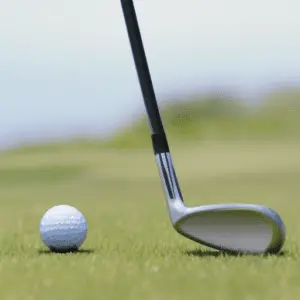Last Updated on October 13, 2023
Do you want to know how to shallow a golf swing? If so, then this blog post is for you. Whether it’s your first time swinging the club or looking for ways to improve your game, we’ve got all the information and tips on how to master that perfect shallow golf swing. From getting the proper grip of your club, practising regularly with precision timing, and troubleshooting any hiccups along the way – learn exactly what it takes from us today as we explore in depth just what goes into mastering that magical shallow a golf swing.
Table of Contents:
- Grip It and Shallow It
- The Power of Practice
- Timing Is Everything
- FAQs in Relation to How to Shallow a Golf Swing
- Conclusion
Grip It and Shallow It
Gripping the club correctly is essential for a shallow golf swing. The proper grip should be comfortable and secure, allowing you to control the clubface through impact. To achieve this, start by placing your left hand on the handle of the club with your thumb pointing down towards the ground. Then place your right hand over the top of it so that both thumbs face each other in an overlapping fashion. This will help ensure you maintain control of the club throughout your swing and hit consistent shots.
Your stance is also important when hitting a shallow shot, as it sets up how much power you can generate from your swing. For a shallow shot, aim to have slightly narrower than shoulder-width apart feet with most of your weight shifted onto your front foot at the address position – about 70%. From here, ensure that you keep both knees flexed throughout the entire motion and try not to move them too much during the backswing or follow through, as this could cause inconsistency in ball flight direction and distance travelled.
The secret to a successful shallow shot is an inside-out swing path at impact; viewed from the top, there should be more room between where the ball was addressed and struck. This provides increased loft on the face of your club, creating a higher trajectory without sacrificing accuracy or distance travelled due to its shallower angle in comparison with other types of swings, such as draws or fades, which necessitate greater precision when timing body parts during execution.
Once contact has been made with the golf ball, continue swinging until the end result reaches full extension while maintaining balance throughout the entire motion. This will ensure maximum efficiency and consistency when trying to hit those low-flying shots. Finally, remember not to rush any part of the process – take time to practice various drills until desired results are achieved before taking your game onto the course itself.
The Power of Practice

Practising your golf swing is essential for mastering a shallow golf swing. It’s not enough to just read about it. You have to put in the time and effort to perfect your technique. The more practice you do, the better your results will be.
The first step in practising a shallow golf swing is understanding how it works. A shallow golf swing involves keeping the club head low as you move through impact with the ball rather than raising it up high, as most traditional swings do. This helps keep the spin-off of the ball and can help improve accuracy and distance control when hitting shots from different lies on the course.
Once you understand how a shallow golf swing works, it’s time to start practising. Start by taking some slow swings with an empty bucket or another object that won’t move around too much when hit (this will help prevent any unnecessary distractions). Focus on keeping your arms straight throughout each backswing and follow through while maintaining good posture throughout each motion. As you get comfortable with this motion, gradually increase speed until you feel confident that you are executing each part of the motion correctly at full speed without sacrificing form or power output.
Finally, don’t forget about stretching before and after every practice session; doing so will ensure that all muscles involved in performing a proper shallow golf swing are properly warmed up before use and cooled down afterwards for optimal performance levels during play-out on-course conditions.
Timing Is Everything

Golf is a game of precision and timing, and it’s essential to understand the importance of timing when executing a shallow golf swing. The key to success lies in having the right combination of speed, power, and control. To achieve this balance, you must time your swing correctly.
The first step in mastering the shallow golf swing is understanding how much force you need to generate with each shot. This will depend on the club head speed, ball spin rate, and trajectory angle. Once you have determined these variables for each shot type (driver vs iron), then you can begin focusing on timing your swings properly.
As you reach full extension in your backswing, quickly transition into the downswing phase by turning towards the target. This will ensure that all energy generated during the backswing is transferred into forward momentum. As soon as you start to turn, release through impact with a powerful follow-through motion that sends energy up through your hands and arms towards the target line for maximum power.
It is essential to understand the duration of each part of a shallow golf swing to ensure that everything flows together smoothly without any pauses or abrupt movements along either path (backswing/downswing). Generally, it takes about one second for most players to complete their backswings and another second for their downswings; however, depending on individual skill level, some may require more time than others. If this is not corrected early enough during practice sessions before hitting shots out on course rounds, it could result in a slower overall tempo.
FAQs in Relation to How to Shallow a Golf Swing
What is the best way to shallow golf swing?

The best way to shallow a golf swing is to focus on the angle of your clubface at address. You should aim for an angle that’s slightly more upright than the ground, and make sure it stays there throughout your backswing. As you reach the top of your swing, keep your arms in front of you and rotate them around your body while keeping the clubface square.
Finally, as you move into impact, maintain that same angle with your clubface, so it remains square through contact with the ball. This will ensure a shallower swing path which can help improve accuracy and consistency in shot-making.
Why can’t I shallow my golf swing?
Shallow swings are often caused by a lack of flexibility in the hips and lower body. This can lead to an incorrect posture at address, resulting in a swing that is too upright and shallow. To correct this issue, it is important to focus on improving your overall mobility and flexibility through stretching exercises and dynamic warm-ups before playing golf.
Additionally, working with a qualified golf instructor or coach can help you identify any issues with your setup position or technique that may be causing you to shallow out your swing. With patience and practice, you should eventually be able to make the necessary adjustments for better results on the course.
How do you shallow out a swing?
To shallow out a golf swing, you need to make sure your club is approaching the ball from an angle that is lower than usual. This can be achieved by focusing on keeping your arms and hands close to your body throughout the backswing and downswing. Make sure to keep your weight slightly forward towards the target as well. Lastly, ensure that you are swinging with a slight upward motion at impact to get the desired shallowing effect. With practice, these steps will help you achieve a more consistent swing plane for better results on the course.
What does a shallow golf swing look like?
A shallow golf swing is a type of swing where the clubhead travels on a low, flat arc during the downswing. This results in less power and distance than a more vertical or steep swing path. The clubhead will travel along the ground for longer before reaching impact with the ball, resulting in less loft on shots and a lower trajectory. To achieve this type of swing, players should focus on keeping their arms close to their body throughout the entire movement while maintaining good posture and balance. Additionally, they should keep their wrists firm and avoid any extra movement that could cause an overly steep angle of attack at impact.
Conclusion
Shallow a golf swing is an important part of the game, with practice and timing, you can master it. With the right grip and technique, you’ll be able to hit those shots like a pro. Remember that practice makes perfect, so don’t give up if it doesn’t come naturally at first. With enough time and effort, shallow a golf swing will become second nature.



